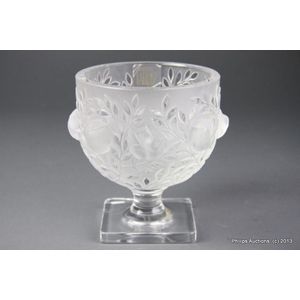Herculaneum Liverpool Pedestal Vase with Summer Flowers
You must be a subscriber, and be logged in to view price and dealer details.
Subscribe Now to view actual auction price for this item
When you subscribe, you have the option of setting the currency in which to display prices to $Au, $US, $NZ or Stg.
- Circa - A Latin term meaning 'about', often used in the antique trade to give an approximate date for the piece, usually considered to be five years on either side of the circa year. Thus, circa 1900 means the piece was made about 1900, probably between 1895 and 1905. The expression is sometimes abbreviated to c.1900.
- Faux - A French word meaning "false", but when used in decorative arts, the intention is not to deceive, but to simulate the decorative effects of the more expensive material it is imitating. The term " faux bois" meaning "false wood" refers to a furniture item that has been decorated with a marked grain (woodgrain finish) to imitate a more expensive timber.
- Empire Style - The Empire style was a version of neo-classicism popular from 1800 to 1830, coinciding with the rule of Napoleon I from 1840-15. In England the style corrosponds with the Regency style and in the United States to the Federal style.
The style is inspired by classical Rome and Greece, as reflected in the decorative motifs in the the design such as paterae, guilloches, acanthus and swags, and pieces are lavishly decorated with applied gilded decoration.
This item has been included into following indexes:
Visually similar items

Fine antique Royal Worcester twin handled urn, painted with roses & foliage by F Harper, dated 1917, good sound condition, no visible restoration or damage, approx 26 cm high

A painted porcelain vase in the Worcester style, raised on a socle, the cobalt blue baluster shaped vase with flared rim decorated with a panel of roses, morning glory and foliage, a panel with a single rose to the reverse, gilt caryatid handles and a gold

A lemon ground pedestal vase attributed to Swansea, circa 1815-20, an ovoid vase with high set volute handles with rosette terminals, a flaring neck and square base, having a gilt rococo reserve with sprays of wheat ears enclosing an imaginary river view,

A Lalique Elizabeth footed vase, circa 1950s, the frosted moulded bowl with a frieze of small songbirds in relief within leafy scrolled branches, upon a slender waisted stem to a square clear glass pedestal base; etched Lalique France to base and with orig
